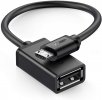D
Deleted member 103366
Guest
I know that some USB cables are designed to pass ONLY power whilst other USB cables are desgined to pass both data and power. I also know that cables apparently differ in their the power and, where applicable, data transfer rates.
What I do not know and can not find is a clear statement as to whether a cable referred to as an "OTG cable" differs for a 'normal' 'power and data' cable. If an OTG cable does differ from a 'normal' power and data cable how does it differ?
What I do not know and can not find is a clear statement as to whether a cable referred to as an "OTG cable" differs for a 'normal' 'power and data' cable. If an OTG cable does differ from a 'normal' power and data cable how does it differ?












